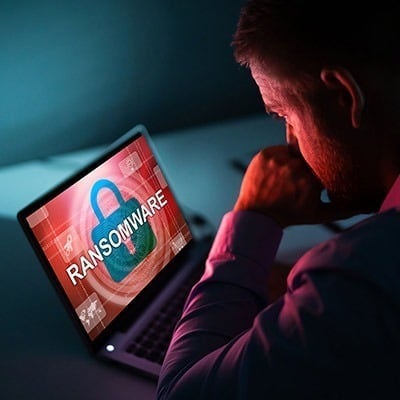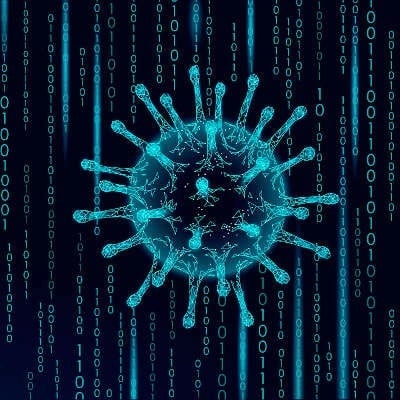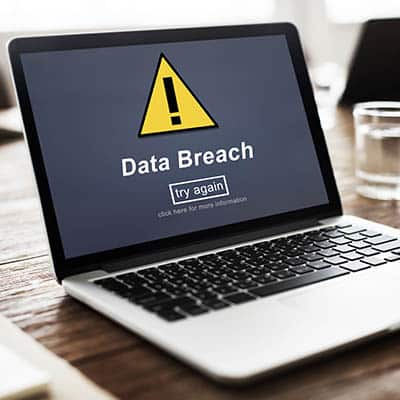Ransomware can be disastrous for any business that gets hit by it, but not always in the way that you might expect. It might threaten business continuity and compromise data security, but it can also directly impact the way that the public views your company. In fact, the decision you make about whether or not to pay the ransom can be a major deciding factor in whether a customer will stick with you.
One of the most dangerous threats out there is ransomware, and for good reason. In many cases, the problems from ransomware can have far-reaching and devastating consequences for businesses, no matter which industry they operate in. Let’s take a look at why ransomware is so problematic and what you can do to stop it.
There are many cybersecurity threats out there, but the one that has cemented itself in the minds of business owners in recent years is ransomware. Ransomware encrypts data on the victim’s devices, forcing them to pay a ransom for the decryption key. As you might imagine, this practice is quite lucrative for cybercriminals—some more than others, of course.
While some threats don’t waste any time when they install themselves on your devices, like ransomware and malware, others tend to lurk in the background on your device and cause problems without being detected. A threat called MosaicLoader is one such threat, and it’s a pretty serious issue for businesses.
If you use almost any Apple products, you’ll want to check for and apply an update that will prevent your devices from being spied on. Apple has just issued an emergency software update for a critical vulnerability that was recently discovered. The new updates were pushed out on Monday, September 13th, 2021, and include a major security fix for the Apple iPhone, Apple iPad, Apple Watch, and Apple Mac computers and laptops.
Numbers are still coming in as far as how widespread this issue is. As of Monday, cybersecurity firm Kaspersky Lab said potentially thousands of Asus computers were infected, but on Tuesday that number has potentially broken a million. How Could My Asus Laptop Get Hacked? This type of attack is called a Supply-Chain Compromise and is one of the most frightening kinds of cybersecurity threats out there. Asus’s software update system was compromised by hackers, putting a backdoor into consumer devices. The scariest part is that this backdoor was distributed last year and it’s just being noticed now. The good news is this has given Asus plenty of time to plug up the security holes on their end, but if you own an Asus device there is still a chance that it is infected with malware from the initial attack. What Do I Do Now? First and foremost, no matter what brand of computer or laptop you have, you need to make sure you have antivirus, and that antivirus needs to be licensed and kept up-to-date. If you have an Asus device, Asus has released an update in the latest version of their Live Update Software. They’ve also patched their internal systems to help prevent similar attacks from happening in the future. You’ll want to make sure you have Live Update 3.6.9 installed. Asus has also released a security diagnostic tool that will check your system to see if it has been affected. Click here to download the tool. We HIGHLY encourage you to reach out to SRS Networks if you are running any Asus hardware. It’s better to be safe than sorry.
Do Macs Get Viruses? In short, the answer is yes, absolutely. Apple computers can get infected with malware like viruses and ransomware. Macs can also suffer from other typical PC problems, such as hardware failure, data loss, slowing down over time, crashes, and more. So where did this misinformation come from? Why do so many casual users tend to think that Macs don’t suffer from the same issues as the Windows PC? Once place to start is Apple’s own (brilliant) advertising. You have to admit, Apple has had some very memorable advertisements over the years. In fact, one of my favorite ad campaigns may be one of the reasons that so many people think that Macs are immune to viruses. Check out the Mac. Vs PC commercial here. These ads are cute and charming and feel honest enough to be true. To Apple’s credit, no lies are being told in the ad. Swarms of new viruses are created for Windows PCs every year, and many of these viruses can’t infect Mac computers. Macs still get viruses, but there are definitely more variants out there for PC. Why is this? PCs Vastly Outnumber Macs In 2018, it was estimated that for every 10 active PCs on the Internet, there was only one Mac. If roughly 90% of the world runs on Microsoft Windows, it makes much more sense for hackers to develop viruses that would affect this broader target. Most businesses use PCs. Most schools and universities use PCs. In fact, most industries tend to use PCs. Most home computing is done on PC as well. That isn’t to say that there is anything wrong with a Mac. Apple makes incredibly solid laptops, and extremely capable desktops. The problem lies with third-party developers. For many businesses, certain core applications don’t have Mac versions. On top of that, when compared to the PC market, Apple doesn’t have a low-end tier for hardware. Your billing department doesn’t need the same computer that your video editor would use, and there isn’t a reason to spend that kind of money on a high-end Mac when a mid-range PC will handle the workload just fine. There really isn’t anything that you can do on a $2000 MacBook that you can’t do on a $2000 Windows laptop – at that point it’s just about preference and what works for your business. On the flipside, there are some limitations to what you can do on that Mac; when it comes to easily connecting and using a business network that’s designed for PCs, and when it comes to the software mentioned above. So, Mac Owners Do Need to Worry About Viruses? Yes sir. Although historically, there haven’t been as many viruses targeting Macs over the years, and it’s always felt like Macs might have a slightly lower risk, that has been changing. According to a recent report by Malwarebytes, the amount of malware on Macs is actually outpacing PCs for the first time ever. It sounds like hackers are relying on the complacency of Mac users. Malwarebytes goes on to report that there was a 400 percent increase in threats on Mac devices between 2018 and 2019. Mac users need to worry about the same threats, and practice the same security hygiene as any other computer user. Whether you […]
May Citrix – May 2, 2019 Citrix, a conferencing and digital workplace software company revealed that hackers gained access to the company’s internal systems between October 2018 and March 2019. Data stolen included Social Security numbers, financial information, and data of current and former employees. AMC Networks – May 3, 2019 Names, email addresses, subscription details and other information of 1.6 million users of AMC Network’s Sundance Now and Shudder streaming services were left exposed through a database that was left unsecured. Freedom Mobile – May 9, 2019 Canadian mobile provider Freedom Mobile had an estimated 1.5 million customers’ personal and financial information left exposed on a third-party server. The types of data left exposed included names, email addresses, mailing addresses, dates of birth, and credit card information. Indiana Pacers – May 13, 2019 The business team behind the National Basketball Association’s Indiana Pacers was the victim of a phishing attack. The information that was exposed included names, addresses, dates of birth, Social Security numbers, passport numbers, driver’s license numbers, medical insurance information, card numbers, digital signatures and login information. No number of affected individuals has been given by the team. WhatsApp – May 14, 2019 The Facebook-owned app WhatsApp has experienced a security flaw that provided access to an Israeli government surveillance agency, NSO Group. NSO Group had limited access to the microphone, camera, and WhatsApp message text of the app’s 1.5 billion users. Instagram – May 20, 2019 Another Facebook-owned property, Instagram had a breach that exposed more than 49 million Instagram influencers, celebrities, and brands’ Instagram information when an Indian-based social media marketing company left it exposed. Canva – May 24, 2019 139 million users of Canva, a cloud-based graphic design tool, had their names, usernames, and email addresses exposed when hackers infiltrated their server. First American Financial Corp. – May 24, 2019 A leading title insurer for the U.S. real estate market, First American Financial Corp. had 885 million customers’ Social Security numbers, bank account numbers, mortgage and tax records, wire transaction receipts, and driver’s license images exposed for all customers as far as back as 2003. Other May breaches: Inmediata Health Group, Uniqlo, Wyzant, Flipboard, Checkers (the fast food chain). June Quest Diagnostics – June 3, 2019 Almost 12 million patient records have been compromised when hackers took control of the payments page of AMCA, a major payment vendor for Quest Diagnostics. Data such as financial account data, Social Security numbers, and health information (ePHI) were left exposed. LabCorp – June 4, 2019 In the same hack, LabCorp announced that 7.7 million of its customers were impacted. Emuparadise – June 10, 2019 The gaming website Emuparadise had their users’ IP addresses, usernames, and passwords exposed in a data breach. Evite – June 11, 2019 More than 100 million users of the Evite event planning app have had their information put up for sale on the dark web. Information that was stolen included names, email addresses, IP addresses, and cleartext passwords. Some even had their dates of birth, phone number, or postal address exposed. Total Registration – June 11, 2019 Kentucky-based Total Registration, a facilitator of scholastic test registrations had their entire service compromised. Victims, who were mainly students who had registered for PSAT and Advanced Placement tests, had their names, dates of birth, grade level, […]
If you want to make the most out of this guide, it helps to print this out. Viruses A computer virus is the most recognized form of malware. A virus is a malicious piece of code that can replicate itself and distribute itself without the person who created it getting involved. Viruses can be devastating threats when utilized by those who know how to make the most of them, and they aren’t limited by industries or business sizes. Viruses can often be attached to files and applications that the victim is supposed to download. Worms Worms are yet another self-replicating threat that have been around for longer than viruses. When a system gets infected, a worm can create situations where additional malware can be transferred into the system, as well as further problems with the system memory. Communications can be cut, too, making it a dangerous situation to be in. Email is the primary method of spreading these worms, and anyone who clicks on the wrong email attachment could spread it to an entire network. Spyware Spyware can be used by criminals to bypass a system’s security by monitoring the user’s actions, recording credentials, and browsing their behaviors. Keyloggers are perhaps the most well-known spyware variant, as they can record a user’s keystrokes to steal credentials and other critical data. Spyware is also known to use up valuable CPU resources to make computers even more vulnerable to threats. Adware Adware is malware that can trick users into clicking on it thinking they are legitimate ads. In reality, they are forced advertisements that redirect users to malicious websites or malicious downloads. Malvertising Criminals can even hide their attacks behind legitimate advertising networks. They might pay for ad space and hide code within the ad, forcing users to go to a malicious site. These malicious sites can install malware on the user’s system and run scripts that turn devices into cryptomining puppets. Some might even install Trojans or ransomware for further insult. Trojan Horse A Trojan Horse threat can hide malware in legitimate programs, and they are so easy to pull off that even a novice hacker can do it. Once the user activates the threat, the payload is delivered, making the situation even worse. Ransomware Ransomware can target businesses, healthcare organizations, municipalities, and individual users with the threat of losing access to critical data and information. Ransomware encrypts data that is found on the infected system, effectively locking the user from accessing infected files. The user must then pay a ransom using cryptocurrency to receive the decryption key. Many victims pay the fine, but never actually receive the key, making this method of recovery unreliable at best. We recommend having a chat with a trusted IT resource to prevent this from becoming an issue for your business. Logic Bomb The logic bomb is what boils down to a digital landmine that sits in your system until something triggers it. A logic bomb can damage a computer and put stress on physical components, overworking hardware and causing hard drives or cooling fans to overheat. Backdoor A backdoor allows criminals to access a device at a later date, providing an outlet to cause even more damage in the long run. The idea is to use another threat as a distraction to allow the […]
- 1
- 2









